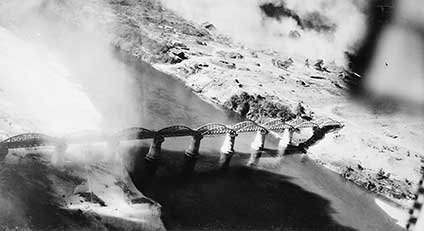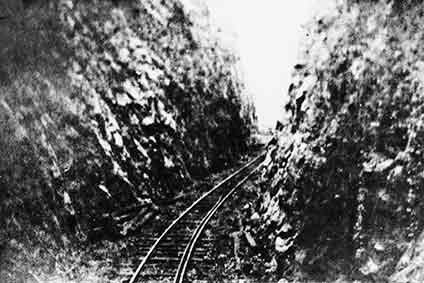The Thai–Burma railway was built in 1942 and 1943 to supply the Japanese forces in Burma (Myanmar), bypassing the sea routes that were made vulnerable when Japanese naval strength was reduced in the Battles of the Coral Sea and Midway in May and June 1942.
Construction began in October 1942 and was completed on 16 October 1943, stretching 415 kilometres between Nong Pladuk in Thailand and Thanbyuzayat in Burma (now Myanmar).
More than 60 000 Allied prisoners of war were employed in the construction of the Thai–Burma railway, including British Empire troops, Dutch and colonial troops from the Netherlands East Indies and a smaller number of US troops. About 13 000 of the prisoners were Australian.

Source
Over 12 000 Allied prisoners died during the construction of the railway, including more than 2700 Australians.
No other nation in the world in 1943 would have bashed and bullied, and sweated and slaved prisoners to such fantastic lengths for such an object. [quoted in Lionel Wigmore, The Japanese Thrust, Canberra, Australian War Memorial, 1957, 569]
Significant features of the railway in Thailand include the Bridge over the River Kwai (made famous by a movie of the same name), Wampo Viaduct and Hellfire Pass.
Bridge over the River Kwai
Spanning the River Kwae Yai in Kanchanaburi, the bridge over the river was built in across the years of 1942 and 1943 by British prisoners of war based at Tha Markam. It consisted of eleven steel spans on concrete pillars. Materials were sourced from Java and this was the only steel bridge built by the Japanese in Thailand during WWII.

Source
The steel spans of the bridge were originally the dome shaped ones as seen in the above picture taken in 1945. The angular ones were installed after the original ones were destroyed during an Allied bombing raid.
Wampo Viaduct
The Wampo viaduct, constructed in early 1943, consists of a series of trestle bridges following the curve of a sheer limestone cliff which falls into the Kwae Noi river below. The viaduct is still used today and maintained by the State Railway of Thailand.
Standing precariously on the sill, you swing your hammer and the whole trestle shook, especially nerve wracking doing it in the dark with only fire light to see with.
[A.E. Field and L.J. Robertson, ‘The Gap is Bridged’, Australian War Memorial MSS0956]
Hellfire Pass
Hellfire Pass is a 75m long, 25m deep cutting of the Burma Railway dug through solid rock by Australian and Allied POW's during the war. They were required to 'hand drill' detonation holes for blasting through the rock. Prisoners would drill a series of small holes in the rock; one man holding a metal drill or ‘tap’, and another hitting its head with an 8-10 lb hammer. These drill holes would then be filled with explosive and detonated.
.JPG)
It is unknown exactly how many Australians died during the construction of Hellfire Pass, however, there are many graves at the Kanchanaburi War Cemetery of soldiers who died during the time of its construction.

Hellfire Pass during the War - SOURCE
.JPG)
Hellfire Pass Today
This post is dedicated to the lives of the men and women, both POW's and asian labourers, who lost their lives during the construction of the Thai-Burma Railway.
Lest we forget.
Source: http://hellfire-pass.commemoration.gov.au/

.JPG)
.JPG)
.JPG)
.JPG)
.JPG)
Thanks for this. My grandfather Eric Griffits Holterman from the 2/20 Battalion was a POW in this mess and thankfully he made it though, although he didn't last terribly long after the war, as many of them didn't. RIP Pop.
Thanks for reading. It is a pilgrimage I think all Australians who go to Thailand should make.
RIP Eric Griffits Holterman. Thanks for sharing this @truthandanarchy and thanks also to your grandfather for his service.
hi, interesting post, in memorium of those people who lost their lives rest in peace
Thanks for reading. It is a very sombre place.
I'm so happy to read your article I am a filipino and was working in Thailand few years ago, and now I am residing in Myanmar with my husband that's why I am interested in the article for my referrence. Bad thing I never visited that site while I was there. follow you
Congratulations! This post has been upvoted from the communal account, @minnowsupport, by scooter77 from the Minnow Support Project. It's a witness project run by aggroed, ausbitbank, teamsteem, theprophet0, and someguy123. The goal is to help Steemit grow by supporting Minnows and creating a social network. Please find us in the Peace, Abundance, and Liberty Network (PALnet) Discord Channel. It's a completely public and open space to all members of the Steemit community who voluntarily choose to be there.
If you like what we're doing please upvote this comment so we can continue to build the community account that's supporting all members.
It was an interesting place to visit. We found out a very interesting fact regarding the book and movie- The bridge described in the book didn't actually cross the River Kwai. The author had never been to the bridge. He knew that the 'death railway' ran parallel to the River Kwai for many miles, and he just assumed that it was the Kwai which it crossed just north of Kanchanaburi. It actually crossed the Mae Klong river. This was a tourist issue when everyone flocked to see it after the movie. So the Thai authorities renamed the Mae Klong river the Kwai river. His book should have been Bridge over the river Mae Klong - doesn't have the same ring though does it!
That's an interesting fact. And the steel bridge in the pictures is not the original bridge. That was a wooden bridge built a few hundred metres down river from the current one. The remains from the movie bridge are can also be found here too. Thanks for sharing.
Great post my friend, I have been on this rail journey over the bridge back in 1988. Cheers
Thank you for reading
A big warm Steemit Sunday greeting goes out to you Scooter! :-D
Upvoted and High Pawed!
Plus Bonus. :-)
Flatrider
Hey @scooter77, this is a great post. Informative and punctuated by your excellent pictures. It seems we have a common love for Aussie war history. Thanks for sharing.
Thanks for looking. I'll be sure to get a post on Hiroshima done too. Thanks for inspiring!
You're welcome. :) I look forward to your post.